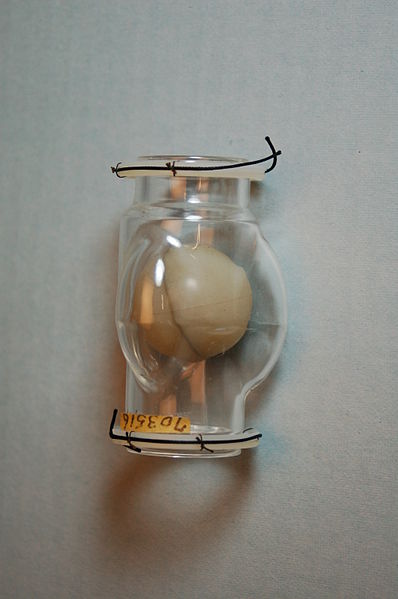
Credit: National Museum of Health and Medicine / Wikipedia
The aortic valve is the valve that allows blood out of the heart into the aorta, but not back. As people get older it’s not uncommon for the aortic valve to accumulate calcium deposits, stiffen, and not open as widely. This condition is called aortic stenosis. As the aortic valve narrows, it impairs the blood flow through it. Patients can develop heart failure, lightheadedness, chest pain, and fainting. There are no effective medications for aortic stenosis. Until several years ago the only treatment was valve replacement through open-heart surgery.
The first aortic valve replacement was performed in 1952. The initial mechanical aortic valves were plagued by blood clot formation, requiring patients to take high doses of anticoagulants (blood thinners) forever. Since then many incremental improvements have been made to prosthetic heart valves, but there was only one way to insert them – open-heart surgery. Surgery is quite effective, but it’s risky and has a prolonged recovery. Frail patients who have other medical problems frequently cannot tolerate the surgery. Up until a few years ago patients who could not undergo surgery would eventually die of worsening aortic stenosis.
Several years ago a new procedure for aortic valve replacement was developed. A catheter is placed in a large artery in the leg and threaded to the heart. The prosthetic aortic valve, folded via a miracle of origami engineering so that it can fit inside the catheter, is pushed through the catheter until it reaches the heart. A balloon is inflated to expand the valve into place. This procedure is called transcatheter aortic valve replacement (TAVR).
Since then, several studies have shown that for patients who cannot undergo open-heart surgery or are at extremely high risk from open-heart surgery, TAVR is an effective alternative. Initially TAVR was plagued by complications, but as cardiologists became more familiar with the procedure, and as the prosthetic valve itself incrementally improved (it’s already on its third version) the complication rate has fallen.
A study in 2013 found that about 67,500 aortic valve replacements were done through open-heart surgery every year, and that about 290,000 elderly patients with severe aortic stenosis were candidates for TAVR, with another 27,000 new patients becoming eligible for TAVR every year as their aortic valves worsen or as their health worsens, making surgery too dangerous.
In a rational marketplace, this would be cause for celebration. Hundreds of thousands of patients with a serious disease stand to benefit from a procedure that didn’t exist a decade ago. Their quality of life and possibly their longevity will be enhanced. The developers of the TAVR technology will make a lot of money. Everyone wins.
But our system is far from rational, because we all pay for each other’s stuff. Medicare is projected to become insolvent in the mid-2020s. The last thing the Medicare budget needs is a brand new very expensive procedure that hundreds of thousands of people can get. So Medicare established criteria to regulate who can undergo TAVR. For example, patients have to be examined by two cardiothoracic surgeons and have both of them decide that the patient is not a candidate for open-heart repair before Medicare will cover TAVR. It’s hard to justify these restrictions in terms of patient safety. These can only be motivated by thinly disguised rationing of a new and expensive procedure.
This month a new study in the New England Journal of Medicine (NEJM) compared TAVR to open-heart surgery in patients whose risk for surgery is not as high as in the initial studies. The study showed again that TAVR had equally good outcomes with much faster recovery.
For readers who follow technological change, this pattern is familiar. Open-heart surgery is a mature technology. Its radical breakthroughs and large incremental improvements happened decades ago. Surgical aortic valve replacement is very unlikely to undergo further drastic improvements. TAVR, on the other hand, is new, and is still in the early phase of exponential improvement. Think of word processors in the 90s, digital photography a decade ago, self-driving cars 10 years from now.
As the valve itself and the insertion technique improves, and as cardiologists build more experience, it’s reasonable to predict that TAVR will prove itself effective with patients at lower and lower risk for open-heart surgery. That is, patients who would be reasonable candidates for surgery may in a few years opt for TAVR.
Again, in a rational system this would be heralded as another example of Schumpeterian creative destruction. Surgically implanted valves could eventually go the way of the Polaroid Camera, the typewriter, the dial telephone. Cardiothoracic surgeons would find more productive things to do than replace aortic valves. Most importantly, patients would be much better off.
But instead, patients must now jump through bureaucratic hoops that were inappropriate when they were first implemented and now proven to be clinically unsound. Medicare will of course revise its restrictions, but this will take months, while sick patients wait.
We’re using a 1964 payment system to adjudicate coverage of twenty-first century procedures. Worse, we’re centralizing decision-making when all around us we see examples that leaving decisions to as many different people as possible yields the best outcomes. I would think that the best people to sort out how a patient’s aortic valve should be replaced are the patient’s cardiologist and the patient herself. And in a rational system, the price for TAVR would quickly fall (as it has for smart phones, and cars, and almost everything else you can think of) and she would put down her MasterCard to pay for it.
But instead, Medicare will slightly relax their byzantine rules, and many patients will unnecessarily undergo surgery rather than TAVR. And because of insurance coverage, prices will stay unaffordable indefinitely. And Medicare will still go bankrupt. Meanwhile, because the current system is both so unaffordable and so inadequate, and because some of us have boundless optimism about centralized decision-making, we are considering scrapping the current system and giving everyone Medicare.
Learn more:
Less-invasive heart valve implant outperforms surgery in study (Reuters)
Warning: Medicare May Be Bad for Your Heart (Wall Street Journal opinion)
Transcatheter or Surgical Aortic-Valve Replacement in Intermediate-Risk Patients (NEJM article)
Will TAVR Become the Predominant Method for Treating Severe Aortic Stenosis? (NEJM editorial)
Aortic Stenosis in the Elderly. Disease Prevalence and Number of Candidates for Transcatheter Aortic Valve Replacement: A Meta-Analysis and Modeling Study (Journal of the American College of Cardiology article)
The Healthcare Meltdown (a four-part series I wrote in 2009 about the causes of the problems of the US healthcare system)

